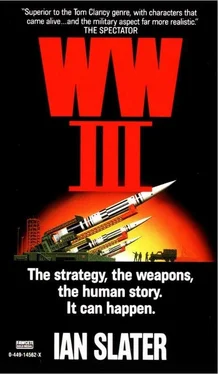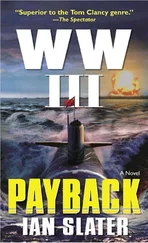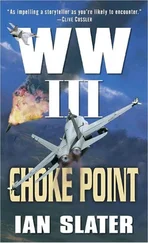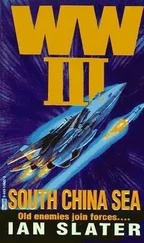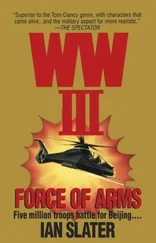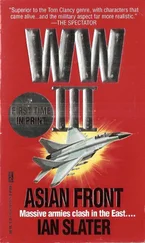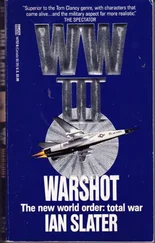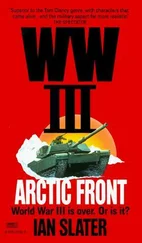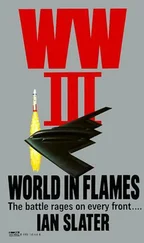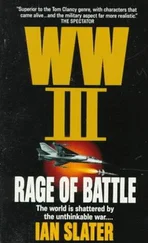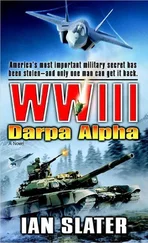“Get under them!” ordered Delcorte. “Four thousand.”
With this the F-16s slid into radar advantage, their electronic look-up of the Sukhoi-15s uncluttered by ground fuzz which would, however, interfere with the Sukhois’ radar look-down images of the American Falcons.
Ten seconds later all four American RIOs (radar intercept officers) armed their air-to-air Sidewinder and Sparrow missiles. Hahn ground control, NADGE, and a NATO rotodome early warning Hawkeye aircraft out of Geilenkirchen all had tracks of the Sukhoi-15s as well as intercepts of East Germany’s Dresden control ordering the Sukhois to confront the F-16s again. CO-MAAFCE — Commander Allied Air Forces Central Europe — at Börfink, in NATO’s command bunker HQ, ordered two more evasive actions.
“Bogeys jinking again,” came Delcorte’s voice. “Twenty-three miles.”
“Bogey jinked on me,” reported another plane. “Noses on at twenty-two miles. Angels four.” This meant the American F-16s were still at four thousand feet. Again Börfink ordered evasive action and again the F-16 Falcons reported the Sukhois had jinked again. At 0411 Börfink gave Delcorte weapons-free— independent decision — authority.
“Master arm on!” Delcorte ordered, his voice, but not the faint growl of the activated missile, on tape at Börfink.
“Master arm on,” came his RIO’s confirmation. “Am centering the T. Bogeys jinked fourteen miles. Centering dot. Fox One. Fox One.” The twelve-foot-long Sparrow missile was off, streaking at over two thousand miles per hour, seen on the early warning Hawkeye’s radar.
“Ten miles,” came in another American pilot. “Fox One. Fox One.”
Another pilot’s voice cut in, “Tally Three. Tally Three. Afterburners,” indicating he could now actually see the crimson eyes of three Sukhoi SU-15s’ afterburners. “Six miles. Select Fox Two. Five miles… four miles… lock ‘im up… lock ‘im up… shoot Fox Two. Fox Two.” Now the shoosh of the shorter, lighter air-to-air Sidewinder missile could be heard on the tape together with the burst of one of the F-16’s twenty-millimeter port side cannons, adding to the general confusion of sound, overriding voices. “Good kill! Good kill!”
At Börfink the tape-connected oscilloscope hiccuped twice. There was a jolting sound, one of the Falcons hit, a scratch of static on the tape, pilot and RIO ejecting. And then in low stratus, above the invisible spread of Germany’s southern Palatinate, the thunder of another two explosions, two of the Sukhois disintegrating at fifteen hundred feet.
* * *
East Germany said nothing. Further arms reduction talks were under way in Geneva. In the West, newspapers picked up the story released from NATO’s headquarters in Brussels: two more F-16s had gone down during low-level practice runs over southern Germany. The F-16, one story reported, was fast taking over the Starfighter in Germany as the “widow maker.” There were more complaints from both the Green Party and even some conservative Christian Democrats that the noise level of the low-flying jets was intolerable. From the villages and towns along the border, a petition was presented to NATO headquarters in Brussels and to the Tenth U.S. Tactical Fighter Squadron, complaining that the noise of the jets was in excess of 123 decibels, “like a train roaring through your bedroom,” one farmer said angrily, and never mind the effects on the children and the farm animals. The latter were so jittery that farmers had long claimed it was adversely affecting the output of milch cows and increasingly devaluating already depressed real estate values along the border. Both claims were true.
NATO HQ said it would seriously consider the protests and reevaluate the low-level attack program, but did neither. Since 1980 NATO had lost 97 fighters, 61 of them two-crew F-16s. In all, 103 dead. Few pilots and radar intercept officers managed to bail out at such low altitudes. But NATO kept up the dangerous low-level flights. The reason was brutally simple. Along the five-hundred-kilometer border of NATO’s central front there were 2,781 NATO aircraft against over 3,050 Warsaw Pact aircraft and a further 4,000 Russian fighters and fighter/bombers between Moscow and the German border. In the event of war, NATO’s only hope against a Soviet “surge” would be to have better planes, but even then they could be overwhelmed, the problem of lost pilots, as in the Battle of Britain, becoming the crucial factor. NATO’s hope resided in developing better pilot and ground crews than the other side’s. In the event of war the NATO/Soviet-Warsaw Pact sortie rate had to be two to one against the Soviet-Warsaw Pact air forces if the West was to stand a chance. In low-level combat, in the battle of razor-sharp wits and split-second radar blips, in dogfights with G-forces so great that they literally drained you of four to seven pounds of fluid a sortie, the concentration needed was enormous.
That afternoon Colonel Delcorte was instructing a new batch of pilots from the States, cautioning them that at such low altitudes the slightest mistake on the touch-sensitive joystick, the slightest reverie, with speeds approaching Mach 1 under two thousand feet, would bring the ground slamming up to kill them. “Any questions?” Delcorte had asked.
A hand shot up.
“Yes?” said Delcorte.
“You said five hundred feet, sir.”
“Yes.”
“Ah, when’s the next flight home?”
It was a joke, of course. Despite such “probing” incidents as the one this morning, deep down no one in the air force, nor anyone else for that matter, least of all Lana La Roche, expected a war. Since Gorbachev, everything had been looking good.
Among her friends Lana Brentwood had always been described as a perfectionist, with energy to burn, a good student who always went the extra distance for the straight A’s and to please. And a good listener, often seeing things in others that they thought were hidden and yet having the ability to convey to whomever she was speaking to a sense that for that moment she wanted to hear only from that person. It helped to fend off, or hold at bay, her secret and enormous dread of failure. It made no difference that she had done well at school, won a scholarship to Harvard’s medical school. She wanted to do everything at once, and everything wouldn’t have it, and one day it all tumbled in on her in one exam, an avalanche triggered by one question in her prerequisite arts course: “Man was born free, yet everywhere he is in chains. Comment.” It wasn’t that she felt she couldn’t answer it, but here were so many reasons Rousseau was right, so many that he was wrong. Like a shopper who, feeling suddenly overwhelmed by the sheer number of choices, in the end walks out and buys nothing, Lana broke out in the perspiration of quiet terror, made some panicky notes with which to start the answer, erased them, wrote them down again. Finally she began to tremble and asked if she could go to the washroom. Worse than her fear that everybody was looking at her was her realization that no one was — all too busy, heads bent, answering the question.
She never went back to the room, and following a six-month stint as a student nurse, from which she again dropped out, the rush of failure after came like a series of storm waves battering down an exhausted swimmer as she tried desperately for the safety of the shore, never making it. Her father, John Brentwood, a sixty-five-year-old ex-naval captain, once retired with high honors from the navy and now on the brink of retirement from his post-naval New York Port Authority job, was a man who had led what he called a “no-nonsense” life, one of duty, discipline, and duty. He was for Lana, however, extraordinarily kind when he sat down with her, putting his arm about her, comforting her, telling her that there was more to life than exams and that perhaps she should think about something else where the pressure wasn’t so great.
Читать дальше
